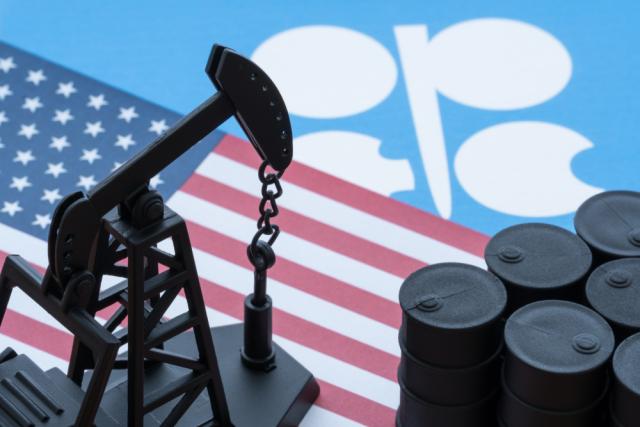
As the geopolitical landscape shifts – evidenced by the unexpected production cut — the implications are becoming increasingly apparent, Iak says. (Source: Shutterstock)
Matthew Iak is the executive vice-president at U.S. Energy Development Corp. The views expressed are his own.
Following the surprise April 2 announcement that OPEC+ intends to cut production, the dominant narrative behind the decision to reduce oil output centered on its immediate impact — penalizing those who have “artificially suppressed” oil prices below existing supply and demand fundamentals.
As a result, the move has dramatically tightened the gap between the physical and futures markets. While it’s apparent that traders with short oil positions are suffering significant damage, it’s difficult to fathom that punishing market traders is the sole reason behind this drastic shift in policy. What’s really at stake is four decades of precedent and process.
Are the underlying reasons behind OPEC’s abrupt policy shift truly based on their long-term strategic views? If that’s the case, it’s possible that Saudi Arabia and other key players within OPEC+ have sent a strong twofold message. They’re acknowledging that China and India are their primary customers and that OPEC has become less susceptible to the influence of U.S. policies. It’s entirely possible that the current administration’s unfulfilled pledge to replenish the Strategic Petroleum Reserve should oil drop below $80/bbl could result in a permanent rupture between OPEC+ and the U.S. Worse yet, could the production cut be designed to prevent the U.S. from refilling its strategic reserves at a low price, subsequently limiting our ability to act as a market manipulator in the future? And what if Saudi Arabia ends up developing closer ties to Russia, Iran and China at the expense of the U.S.?
U.S.-Saudi relations deteriorate
More than seven decades ago, the U.S. and Saudi Arabia established a close alliance. One that was based on a transactional premise: the U.S. would provide security guarantees for Saudi rulers, who in return promised access to the Kingdom’s vast oil reserves. But today, the U.S. is much less dependent on Saudi oil, and consequently, they’ve become less trusting of U.S. security guarantees. In a tense environment such as this, seemingly small disputes between the two countries now feel like potential rifts.
What spurred the current tension between our previously unshakable partnership? Was it President Joe Biden’s policy to shun the Kingdom’s de facto leader, Crown Prince Mohammed bin Salman, over the 2018 murder of Washington Post columnist Jamal Khashoggi? Or was it the U.S. decision to tap into the strategic oil reserves as a political and market tool, without consent or agreement from our international partners? Could another contributing factor be the domestic shift in woke ideology that undermines Saudi beliefs and threatens their economic foundation? All told, it’s likely a combination of all these factors — and maybe more.
In July 2022, with oil prices spiking due to the conflict in Ukraine, President Biden flew to Saudi Arabia to request an increase in oil production. He was rebuffed. Instead, OPEC+ decided to cut production only three months after his visit, just prior to the 2022 midterm elections.
Historically, we’ve certainly seen deals to raise or lower oil prices prior to U.S. elections. But this production cut is beginning to look like another direct slight, aimed at our powerless administration. Ultimately, it underscores Saudi Arabia’s lack of confidence in the U.S.’ ability to influence price on our own through flexibility in production. In the past, a cut in oil production would have typically been counterbalanced by an increase in shale production, thereby weakening Saudi Arabia’s dominant position. However, current U.S. policies have constrained domestic production, giving the Kingdom assurance that they can better manipulate the price of crude without Western interference.
This decision has placed the U.S. in a precarious and tight position, with shale executives already pledging to hold oil output steady this year so they can focus on enhancing investor returns. As a result, oil prices in the world’s largest economy are now largely being driven by decisions made in far-flung places, as well as countries that don’t exactly have America’s best interests in mind.
We seem to be witnessing a blatant power grab that could result in a seismic geopolitical shift. OPEC+ is clearly in control and driving oil prices at exactly the wrong time. Higher oil prices will only add fuel to inflationary concerns in the U.S., which the Federal Reserve has been struggling to contain through a series of rapid-fire interest rate hikes at a pace not seen in decades. The U.S. cannot produce its way out of this predicament, raising the question of whether this situation could have been avoided and, if so, how?
‘An unreliable protector’
Domestic and foreign energy policy has shifted over the past several years, beginning with President Biden’s landmark climate legislation. Passed last summer, it aimed to wean large swaths of the economy off fossil fuels. Though an important initiative, the fossil fuel industry was subsequently hampered by additional roadblocks and restrictions while attempting to carve a narrow path forward. But adjust they did.
Three years ago, exploration and production companies forged their own path, prioritizing dividends and share buybacks over new exploration and drilling. As a result, they no longer chase production growth at any cost and have adopted a more conservative stance centered on capital discipline.
Currently, Saudi Arabia seems to view the U.S. as an unreliable protector — citing our 2021 exit from Afghanistan as well as the withdrawal of support for Egyptian President Hosni Mubarak, a U.S. ally, during the widespread protests that led to his downfall, among other reasons. They grouse about what they call “U.S. disengagement from the Middle East,” arguing that we’ve actually done little to contain the expanding influence of Iran — the Kingdom’s primary adversary for regional dominance.
And in March, Saudi Arabia and Iran agreed to restore diplomatic relations in a deal brokered by China. It appears to be another signal that the Kingdom is urging the U.S. to get in line, maybe even to heel, as we’re clearly no longer their most important partner.
As the geopolitical landscape shifts – evidenced by the unexpected production cut — the implications are becoming increasingly apparent. With a growing global population and rising energy demands, traditional energy sources remain essential to meet the world's basic energy needs.
But is the U.S. ultimately losing its global influence as a result of our short-sighted energy policies? Perhaps. That’s why it’s important to recognize the importance and pivotal role that energy has traditionally played in the rapid advancement of the U.S. and the world over the past 150 years.
It’s suddenly possible that shifting the narrative to make energy more efficient through renewable initiatives may be the only way out of this mess. But the reality of the situation remains in stark contrast.
It never was a choice between renewables or traditional energy. Is it possible that maybe, just maybe, politics may have cost us more than we anticipated?

Matthew Iak is the executive vice president of U.S. Energy Development Corp. and serves on the company’s board of directors. He can be reached at miak@usedc.com.
Recommended Reading
TPG Adds Lebovitz as Head of Infrastructure for Climate Investing Platform
2024-02-07 - TPG Rise Climate was launched in 2021 to make investments across asset classes in climate solutions globally.
Air Products Sees $15B Hydrogen, Energy Transition Project Backlog
2024-02-07 - Pennsylvania-headquartered Air Products has eight hydrogen projects underway and is targeting an IRR of more than 10%.
NGL Growth Leads Enterprise Product Partners to Strong Fourth Quarter
2024-02-02 - Enterprise Product Partners executives are still waiting to receive final federal approval to go ahead with the company’s Sea Port Terminal Project.
Sherrill to Lead HEP’s Low Carbon Solutions Division
2024-02-06 - Richard Sherill will serve as president of Howard Energy Partners’ low carbon solutions division, while also serving on Talos Energy’s board.
Magnolia Appoints David Khani to Board
2024-02-08 - David Khani’s appointment to Magnolia Oil & Gas’ board as an independent director brings the board’s size to eight members.





